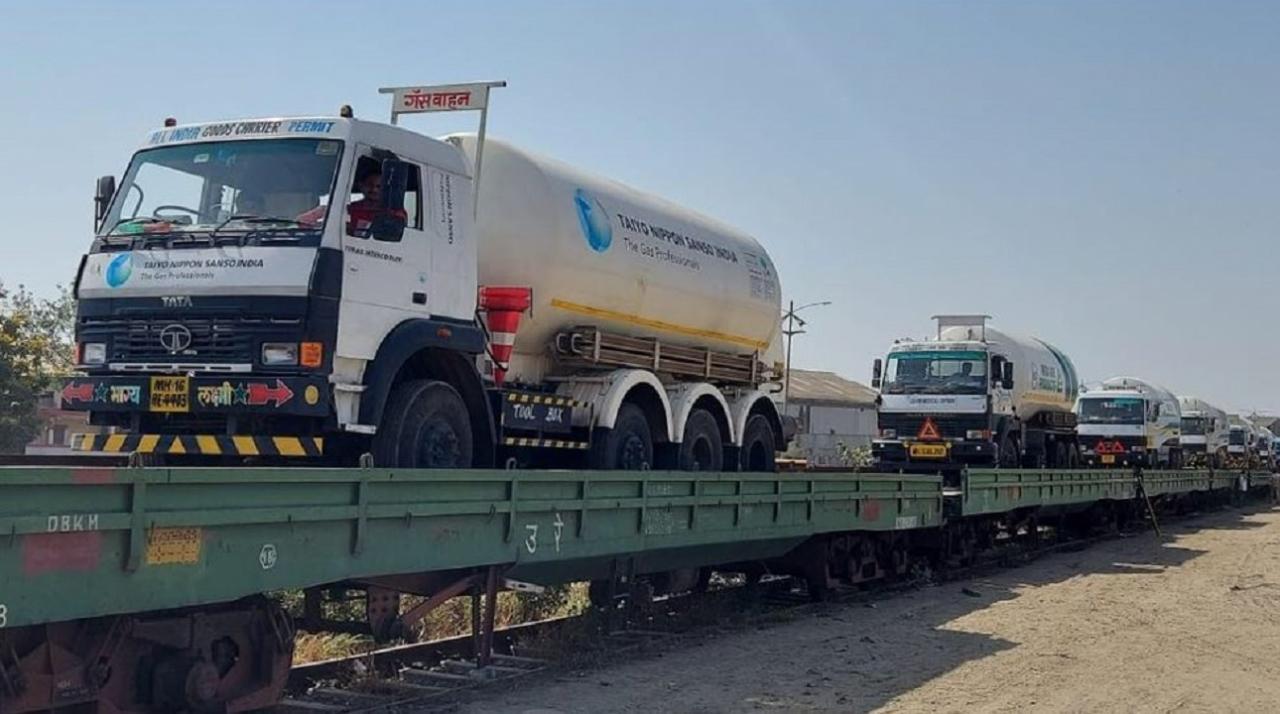
First Oxygen Express reaches Maharashtra, here’s how it was planned
The Oxygen Express arrived in Nagpur at 8.10 pm on Friday and reached Nashik on Saturday morning.

Oxygen Express carrying seven tankers. Pics/Rajendra B Aklekar
The first Oxygen Express carrying seven tankers filled with liquid medical oxygen from Visakhapatnam reached Maharashtra on Friday night. It arrived in Nagpur at 8.10 pm on Friday and reached Nashik on Saturday morning.
“Railways took the movement of “Oxygen Express” as a challenge and successfully ran the first oxygen express from Kalamboli to Vizag and back up to Nashik. The moment railways got the request, ramps were made at various places immediately for the movement of liquid medical oxygen tankers. The work done by the team in Mumbai must be appreciated as the ramp was made within 24 hours at Kalamboli,” Central Railway chief public relations officer (PRO) Shivaji Sutar told mid-day.
Why the train was taken via Vasai-Surat-Jalgaon-Nagpur route?
“For the movement of Ro-Ro service, Railways had to map the entire route considering the various constraints like Ghat sections, road over bridges, tunnels, curves, platform canopies, overhead equipment, etc. at certain locations. The Mumbai division has two ghat sections - south and north side i.e. Bhor Ghat on south east side and Kasara –Igatpuri ghat on north east side. The height is an important aspect/parameter in the movement of Ro-Ro service. The rolling stock to transport liquid medical oxygen i.e. the model of road tanker T1618 with a height of 3320 mm and DBKM flat wagons with height of 1,290 mm is not permitted to carry/travel in ghat sections due to the height restrictions in tunnels, OHE wire, etc. and safety reasons. Hence, the route was mapped via Vasai, Surat, Jalgaon,” explained Shivaji Sutar.
“Also oxygen is cryogenic and hazardous chemical, Railways have to avoid sudden acceleration, deceleration, have to check pressures in between, especially when it is in loaded condition. These operations are unsafe in Ghat section. Yet, railways took it as challenge, mapped the route, trained people and could take these particular size tankers to Vizag via Vasai, Surat, Bhusaval, Nagpur route,” he added.
‘Transportation of oxygen through trains is more convenient’
“The distance between Kalamboli and Vizag is more than 1,850 kms which was completed by these tankers in only about 50 hours. Seven tankers with more than 100 tons LMO (Liquid Medical Oxygen) were loaded in 10 hours and transported back to Nagpur in only 21 hours. Railways have unloaded 3 tankers in Nagpur on Friday and the remaining 4 tankers have reached Nashik at 10.25 am on Saturday i.e. in just 12 hours. Transportation of Oxygen through trains is faster over long distances than road transport. Trains can run 24 hours in a day but a truck drivers need to take halts. The green corridor is created for the faster movement of these tankers and monitoring of movement was done at the apex level,” Sutar said.
Monitoring at apex level
The movement of Oxygen Express is being monitored not only at divisional levels but also at zonal, railway board and at minister level. The green corridors are made to ensure fast, quick and smooth transportation of Liquid Medical Oxygen.
